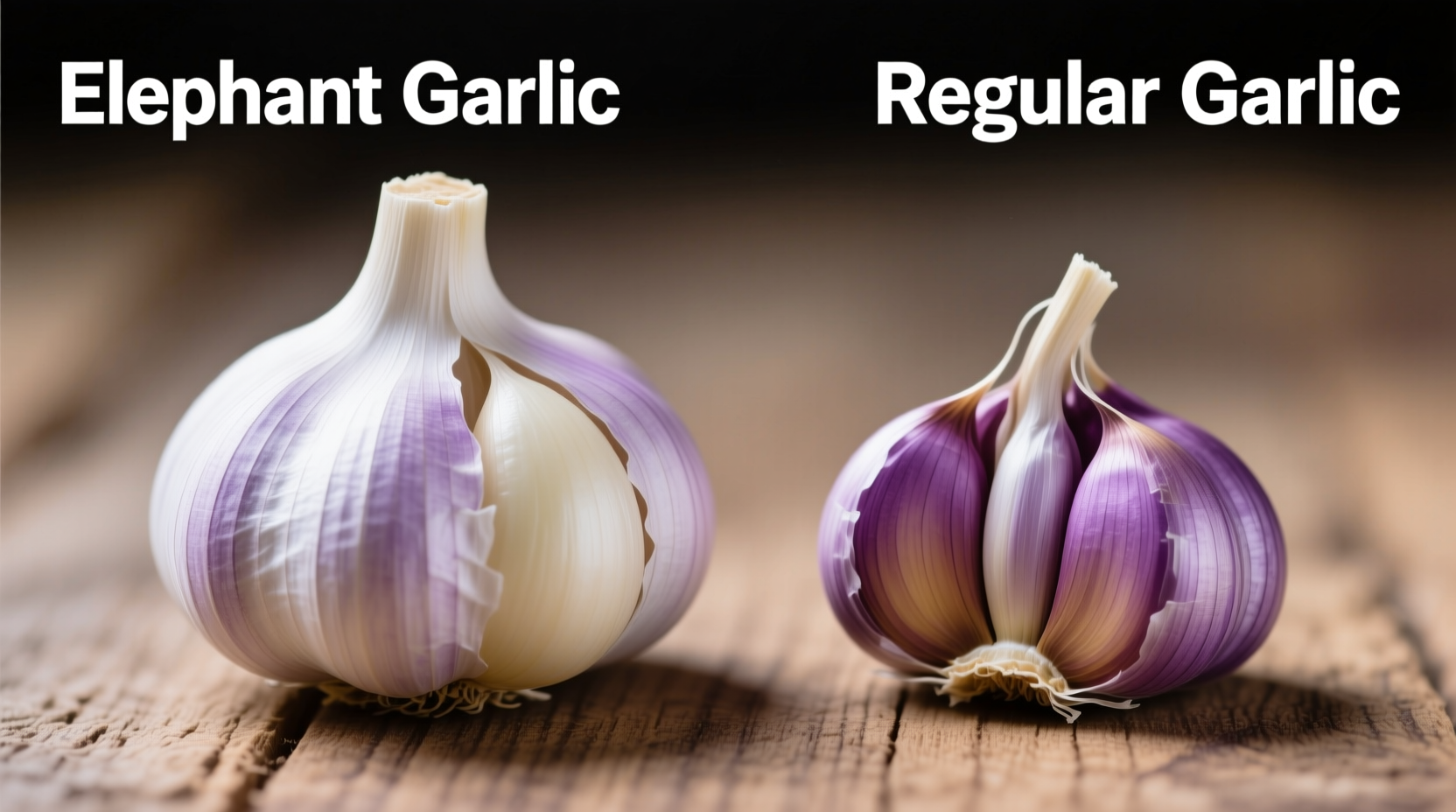Understanding the Fundamental Difference
Despite its name, elephant garlic belongs to the leek family rather than the true garlic species. This botanical distinction explains why elephant garlic lacks the intense flavor punch of regular garlic. According to the USDA Agricultural Research Service, Allium ampeloprasum (elephant garlic) contains significantly lower levels of allicin—the compound responsible for garlic's characteristic pungency and many health benefits—compared to Allium sativum (regular garlic).
| Characteristic | Elephant Garlic | Regular Garlic |
|---|---|---|
| Botanical Classification | Allium ampeloprasum (leek family) | Allium sativum (true garlic) |
| Flavor Intensity | Mild, slightly sweet (1/5 the pungency) | Strong, pungent, complex |
| Clove Size | 2-3 inches long, 1-2 inches wide | 0.5-1.5 inches long, 0.25-0.75 inches wide |
| Number of Cloves per Bulb | 4-6 large cloves | 10-20 smaller cloves |
| Allicin Content | Approximately 20% of regular garlic | High concentration |
Flavor Profiles and Culinary Applications
When comparing elephant garlic vs regular garlic in cooking, the flavor difference dramatically impacts your results. Elephant garlic offers a subtle, almost roasted garlic flavor even when raw, making it ideal for dishes where you want garlic presence without overwhelming heat. Regular garlic provides the complex, pungent flavor profile that forms the foundation of countless global cuisines.
When to choose elephant garlic:
- Raw applications like salad dressings or garlic bread where regular garlic would be too harsh
- Dishes requiring whole roasted bulbs where milder flavor is preferred
- For children or those sensitive to strong garlic flavors
- When creating garlic-infused oils that won't overpower other ingredients
When regular garlic shines:
- Classic Mediterranean, Asian, and Latin American dishes requiring authentic garlic flavor
- Sauces and stews where garlic forms a flavor foundation
- When you need the characteristic garlic aroma to permeate a dish
- For maximum health benefits from higher allicin content

Nutritional Comparison and Health Benefits
While both varieties offer health benefits, regular garlic delivers significantly more potent medicinal properties. Research from the National Center for Complementary and Integrative Health confirms that regular garlic contains approximately five times more allicin—the compound responsible for garlic's cardiovascular and immune benefits—than elephant garlic.
According to USDA FoodData Central, both varieties provide similar vitamin C and B6 content, but regular garlic contains higher concentrations of manganese, selenium, and other trace minerals essential for health. For those specifically seeking garlic's well-documented health benefits, regular garlic remains the superior choice.
Practical Buying and Storage Guide
Selecting quality bulbs: Choose firm bulbs with tight, papery skins for both varieties. Avoid any with soft spots, green sprouts, or signs of mold. Elephant garlic bulbs should feel heavy for their size, indicating plump cloves.
Storage considerations:
- Store both types in a cool, dark, well-ventilated place (not the refrigerator)
- Regular garlic typically lasts 3-6 months when stored properly
- Elephant garlic has a shorter shelf life of 2-3 months due to higher moisture content
- Never store either type in plastic bags, which trap moisture and accelerate spoilage
Common Mistakes to Avoid
Many home cooks make critical errors when substituting these varieties. The most frequent mistake when comparing elephant garlic vs regular garlic is using equal measurements. Due to its milder flavor, you'll typically need 2-3 times more elephant garlic to achieve similar flavor intensity.
Another common error involves roasting techniques. Elephant garlic requires lower temperatures (325°F/163°C) to prevent burning its larger cloves, while regular garlic can handle higher roasting temperatures (375°F/190°C). Understanding these subtle differences transforms your cooking results significantly.
When Substitution Makes Sense (and When It Doesn't)
Substituting elephant garlic for regular garlic works well in applications where you want a subtle garlic presence:
- Garlic mashed potatoes
- Raw garlic sauces like aioli
- Vegetable roasts where garlic shouldn't dominate
Never substitute elephant garlic when:
- Authentic flavor is critical (traditional pesto, aglio e olio, or garlic-heavy Mediterranean dishes)
- Seeking maximum health benefits from garlic consumption
- Creating garlic confit where strong flavor development is essential











 浙公网安备
33010002000092号
浙公网安备
33010002000092号 浙B2-20120091-4
浙B2-20120091-4